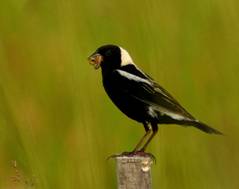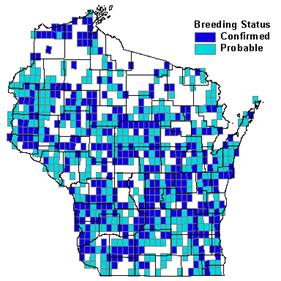Photo by Dennis Malueg


Status/Protection
- Global Rank: G5 Key to global and state ranks
- State Rank: S3S4B, SZN
- WBCI Priority: SGCN, PIF
Population Information
Federal BBS information can be obtained at http://www.mbr-pwrc.usgs.gov/bbs/bbs.html by clicking on Trend Estimates and selecting the species in question. All estimates are for 1966-2005.
- Federal Breeding Bird Survey: significant decline
- Federal Breeding Bird Survey (WI): significant decline
- Federal Breeding Bird Survey (BCR 23): significant decline
- Federal Breeding Bird Survey (BCR 12): significant decline
- WSO Checklist Project: signifcant decline (1983-2007)
Life History
- Breeding Range: British Columbia east to Newfoundland southward to Colorado, Illinois, and West Virginia (Martin and Gavin 1995).
- Breeding Habitat: Small Grains, Fallow Field, Hay, Pasture, Idle Cool-season Grasses, Idle Warm-season Grasses, Dry-mesic Prairie, Wet-mesic Prairie, Wet Prairie, Oak Opening, Southern Sedge Meadow and Marsh, Northern Sedge Meadow and Marsh, Open Bog-Muskeg.
- Nest: Ground.
- Nesting Dates: Eggs: mid-May to early July (Renfrew 2006).
- Foraging: Ground and foliage glean.
- Migrant Status: Neotropical migrant.
- Habitat use during Migration: Unknown.
- Arrival Dates: Late April to late May.
- Departure Dates: Late July to early September.
- Winter Range: Pampas of SW Brazil, Paraguay, and Argentina.
- Winter Habitat: Grasslands and agricultural fields.
Habitat Selection
Bobolinks prefer mid-successional grasslands with moderate litter layer, standing residual vegetation, and moderate grass:forb ratios with little to no woody vegetation. Dominant breeding habitat in Wisconsin includes alfalfa, grass hay, pasture, idle medium height grassland, old field, mesic prairie, and northern sedge meadow (Sample and Mossman 1997). Bobolinks seem to be moderately area-sensitive (Dechant et al. 2003) requiring grassland patches > 10 hectares (Sample and Mossman 1997, Knutson et al. 2001).
Birds form flocks and stage in freshwater marshes for pre-basic molt in fall. They are attracted to sites with abundant annual seed crops such as wild rice or smartweed. Bobolinks winter in the pampas of South America in grasslands, marshes, rice, and sorghum fields (Martin & Gavin 1995).
Habitat Availability
Bobolinks are found in a wide variety of mid-successional native and non-native grassland types, resulting in a broad distribution throughout the state. Many of the non-native grasslands used by Bobolinks are still fairly common throughout the state. However, old fields are vulnerable to conversion and alfalfa/hay fields are ecological traps when mowed during the breeding season. Conservation Reserve Program (CRP) fields have increased the amount of idle grassland available to Bobolinks; however, there is no assurance that the land will not go back into crops when the contract has expired (Knutson et al. 2001).
Population Concerns
Bobolinks were historically abundant in prairies and oak savannas of southern, western, and central Wisconsin. After settlement they adapted to hay and pasture when prairie sod was broken and even expanded their range northward as former forested regions were converted to dairy-based agriculture (Renfrew 2006). Loss of grasslands and intensification of agriculture have resulted in population declines in Wisconsin and North America. Since 1966, Bobolinks have declined by almost 2% per year in Wisconsin (Sauer et al. 2005). During the six-year census period (1995-2001) of the Wisconsin Breeding Bird Atlas, observers recorded Bobolinks in 66% of all quads with breeding confirmed in 45% of those (Renfrew 2006).
Although Bobolinks are still found throughout the state, conservation measures are needed to increase the quality and quantity of grassland habitats to maintain a viable population. Loss of grassland habitat and the intensification of agriculture are concerns in Wisconsin (WDNR 2005). On the wintering grounds, Bobolinks are shot and trapped as an agricultural pest and males are sold in the local pet trade. It’s not clear if stopover habitat along the migration route limits Bobolink populations today.
Recommended Management
Bobolink conservation requires restoration and management of large grassland landscapes. Restorations should seek to create patch sizes greater than 10-30 hectares with little woody edge. Management of grassland patches through burning, mowing, or grazing should be done on a 3-6 year rotation in order to limit woody vegetation and provide adequate amounts of mid-successional grassland. Avoid disturbing more than 50% of smaller patches and 20% of larger patches on an annual basis (Dechant et al. 2003). Mowing should be delayed until after July 15 to protect fledglings and late nesters. If mowing cannot be delayed, one possible solution is to mow from inside out to provide fledglings an escape route. Also, idle lands adjacent to cut fields may allow for second nest attempts since bobolinks will abandon fields mowed during the breeding season.
Conservation and management strategies for this species should be focused in the following Wisconsin ecological landscapes: Southwest Savanna, Central Sand Plains, and Southeast Glacial Plains. Key sites include Buena Vista Wildlife Area, Thompson Prairie Grasslands, Muralt/Monroe Grasslands, Bong Recreation Area, and Crex Meadows Wildlife Area.
Research Needs
Additional research is needed regarding conservation on the wintering grounds (Martin and Gavin 1995) including the effects of land use changes and pest control methods (Renfrew 2006). Little is known about the important stopover sites along their long migration route (Martin and Gavin 1995). Restoration efforts meant to increase nesting habitat for this species should be evaluated to better inform future efforts.
Information Sources
- Knutson, M.G., G. Butcher, J. Fitzgerald, and J. Shieldcastle. 2001. Partners in Flight Bird Conservation Plan for The Upper Great Lakes Plain (Physiographic Area 16). USGS Upper Midwest Environmental Sciences Center in cooperation with Partners in Flight. La Crosse, WI.
- Managing Habitat for Grassland Birds: A Guide for Wisconsin: http://www.npwrc.usgs.gov/resource/birds/wiscbird/
- North American Breeding Bird Survey: http://www.npwrc.usgs.gov.
- Temple S.A., J.R. Cary, and R. Rolley. 1997. Wisconsin Birds; A Seasonal and Geographical Guide. Wisconsin Society of Ornithology and Wisconsin Department of Natural Resources, Madison, WI.
- Wisconsin Breeding Bird Atlas: http://www.uwgb.edu/birds/wbba/.
- David Sample, Grassland Community Ecologist, Wisconsin DNR - 608-221-6351.
References
- Dechant, J.A., M.L. Sondreal, D.H. Johnson, L.D. Igl, C.M. Goldade, A.L. Zimmerman, and B.R. Euliss. 2003. Effects of management practices on grassland birds: Bobolink. Northern Prairie Wildlife Research Center, Jamestown, ND. Northern Prairie Wildlife Research Center Online. http://www.npwrc.usgs.gov/resource/literatr/grasbird/bobo/bobo.htm (Version 12DEC2003).
- Knutson, M.G., G. Butcher, J. Fitzgerald, and J. Shieldcastle. 2001. Partners in Flight Bird Conservation Plan for The Upper Great Lakes Plain (Physiographic Area 16). USGS Upper Midwest Environmental Sciences Center in cooperation with Partners in Flight. La Crosse, Wisconsin.
- Martin, S.G., and T.A. Gavin. 1995. Bobolink (Dolichonyx oryzivorus). In The Birds of North America, No. 176 (A. Poole and F. Gill, eds.). The Academy of Natural Sciences, Philadelphia, and The American Ornithologists’ Union, Washington, D.C.
- Renfrew, R. 2006. Bobolink. In Atlas of the Breeding Birds of Wisconsin. (N.J. Cutright, B.R. Harriman, and R.W. Howe, eds.). The Wisconsin Society for Ornithology, Inc. 602pp.
- Sample, D. and M. Mossman. 1997. Managing Habitat for Grassland Birds: A guide for Wisconsin. Wisconsin Department of Natural Resources: Madison, WI.
- Sauer, J.R., J.E. Hines, and J. Fallon. 2005. The North American Breeding Bird Survey, Results and Analysis 1966 - 2005. Version 6.2.2006. USGS Patuxent Wildlife ResearchCenter, Laurel, MD.
- Wisconsin Department of Natural Resources (WDNR). 2005. Wisconsin’s Strategy for Wildlife Species of Greatest Conservation Need. Madison, WI.
Contact Information
- Compiler: Jenny Herrmann, mherrmann4@wi.rr.com
- Editors: Dave Sample, David.Sample@Wisconsin.gov | Kim Kreitinger, K.Kreitinger@gmail.com
